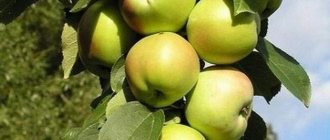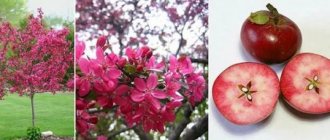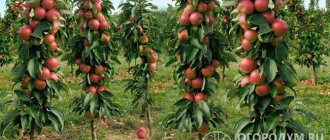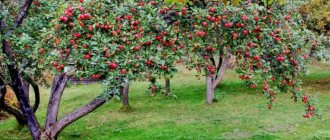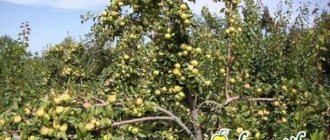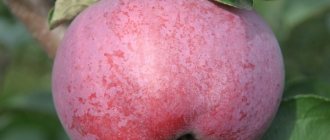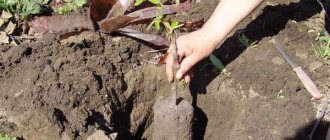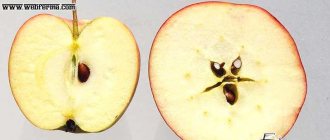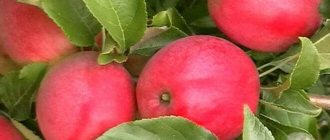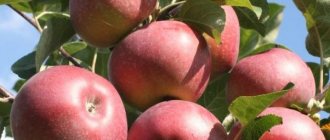Loading…
Loading…
The climate of the Urals and Siberia is characterized by a certain severity and unpredictability. Therefore, apple trees in a given region must have appropriate hardiness and winter hardiness. Currently, quite a lot of breeding varieties of columnar apple trees have been created that are able to grow and produce a good harvest even in the harshest climatic latitudes. They can be divided into 3 groups.
- Ranetki are the most winter-hardy bush-shaped apple trees that have small fruits weighing no more than 15 g.
- Semi-cultured plants have slightly less winter hardiness, but they tolerate normal winters normally. Grown in bush form, fruit weight from 15 to 130 g.
- Stlantsy are large-fruited varieties with low winter hardiness. The formation of a creeping stylized crown is in most cases performed artificially. In addition, several new varieties of natural slates have also been developed.
The most popular varieties of apple trees for the Urals and Siberia are the following:
- Antonovka;
- White filling;
- Melba;
- Padding;
- Welsey;
- Silver Hoof;
- Gift of Autumn;
- Summer Striped;
- Ural Liquid.
However, the Ural region may not be entirely favorable even for specially bred varieties. For example, late frosts can negatively affect apple trees during flowering, destroying the entire crop. Therefore, to create a garden, it is necessary to choose different varieties of apple trees, taking into account their growing season, frost and winter hardiness.
Apple tree Antonovka
Winter frost-resistant variety. Main characteristics:
- a large tree with a spreading crown;
- the fruits of the Antonovka apple tree are large, weighing 125–150 g, with a yellowish-green peel;
- the pulp is white, juicy, tartrate;
- fruit ripening – September;
- yield – 200–300 kg per tree;
- storage – 3 months;
- frost resistance is good;
- The fruits are used fresh, for drying, making compotes, juices, marmalade and marshmallows.
The fruits of the Antonovka apple tree are harvested in September, and consumer maturity occurs a month after harvesting.
Apple tree White Pouring
Summer winter-hardy variety. Main characteristics:
- The height of the tree is average, the crown is rounded, the bud is easy to form;
- the fruits of the Belyi Naliv apple tree are medium, weighing 100 - 150 g, round, with a greenish-yellow peel;
- the pulp is white, coarse-grained, sweet and sour;
- removable maturity occurs in August;
- the yield is 100 kg per tree;
- storage - 2 weeks;
- frost resistance is high, disease resistance is average;
- The fruits are used fresh and for preservation.
The fruits of the White Naliv apple tree are unsuitable for long-term storage because they quickly deteriorate. Therefore, it is best to use them for recycling.
Apple tree Melba
Late summer Canadian variety. Main characteristics:
- a tree of medium height, with a rounded crown; in the Urals and Siberia it is grown in the stylite form;
- The fruits of the Melba apple tree are large, weighing 140-200 g. The peel is light green with a rich red blush;
- the pulp is snow-white, sweet and sour, with a caramel aroma;
- The fruits ripen in August;
- yield – 120 kg per tree;
- storage in a cool room - until January;
- resistance to diseases and frost is average;
- The fruits are used fresh and for processing into compotes and juices.
The Melba apple tree produces many erect, long shoots, which make it difficult to form into a stale tree. Therefore, additional pruning of branches and timely pinching is required.
Gardeners to gardeners
From time immemorial, the apple tree has been the most widespread crop in Russian gardens. Not a single festive table in Rus' could be imagined without lush pies with apple filling and foaming apple cider.
With the development of amateur gardening in the 50s of the last century, the apple tree again took a leading place both in small plots of six hundred square meters and in the large gardens of honored figures of the country.
The varietal diversity of this crop is also great. Domestic and foreign experts count about 12 thousand varieties of this crop for various soil and climatic zones.
For more northern regions there are significantly fewer of them, but it is very difficult for an amateur gardener to understand them and make the right choice of varieties for planting in his garden.
After all, an apple tree takes up quite a lot of space, and you can’t plant more than three or four trees on a six-hundred-acre plot. And here we must also take into account that all varieties of apple trees are divided into three main groups: summer, autumn and winter. And I want to plant everything!
However, with such a choice, experts recommend giving preference to autumn varieties for several reasons. According to what? We’ll talk about this today and tell you why autumn varieties of apple trees are better than summer and winter ones.
In addition, we will help you choose the best ones - tasty, sweet, juicy, unpretentious, not afraid of frost, pests and diseases. This is exactly what our collection of autumn varieties of apple trees consists of, which we have prepared for you!
WHY AUTUMN VARIETIES OF APPLE TREES ARE BETTER THAN SUMMER AND WINTER
We have already written in detail about the history of the creation of cultivated varieties, about the beneficial properties of apples, about planting and caring for this crop, about its varieties in our articles:
“Spring grafting of apple and pear trees”;
“How to grow an apple tree”;
“Ornamental apple trees in your garden”;
“Autumn fertilization of fruit trees”;
"Autumn planting of fruit trees and shrubs."
Today we will tell you why autumn varieties of apple trees are good. But first, let's look at a brief description of all three types.
Summer varieties of apple trees usually ripen by mid-July. They taste very juicy, sweet or sweet and sour and not very large. Summer apples are good to pick straight from the tree and eat right away.
Their big drawback is their rapid overripening. It is impossible to store them. You need to either quickly consume these apples fresh (which is not so easy), or immediately put them into processing (jams, jams, juices, compotes, wine).
Winter varieties of apple trees . They ripen by mid to late October (depending on the variety). But after this period, they still have to ripen for quite a long time so that they can be consumed fresh.
They are the largest in size, but very hard due to the high content of protopectin and starch and are thick-skinned.
In addition, they have a high iron content (most of all in the Antonovka ). They taste sour. A slight sweetness appears after 2 – 3 months.
But the keeping quality of winter varieties is the highest. Some varieties can be kept fresh in special storage for more than a year.
Autumn varieties of apple trees . They ripen in early September. As a rule, autumn apples are large, very tasty, juicy, sweet or sweet and sour. Their skin is not thick (but not very thin either), and has a rich, bright color.
The big advantage of fall varieties is that they can be eaten fresh right away. And they are stored for at least three to four months. The fruits of some varieties successfully “survive” until next summer.
In addition, according to statistics, autumn varieties are the most productive. Many amateur gardeners prefer them because they can be removed at the very beginning of autumn, rather than waiting for the onset of cold weather.
Many summer residents living in summer houses leave for city apartments no later than mid-September, leaving their garden defenseless. And there are many who like to enjoy delicious fruits. In this regard, winter varieties lose greatly.
Autumn varieties have the longest fruiting period (more than a month), so you can pick them from the tree every day and gradually prepare all sorts of canned food and drinks from them and eat them fresh with pleasure.
Even overripe apples of autumn varieties do not lose their amazing taste and aroma.
Autumn varieties of apple trees, as a rule, are the fastest ripening - the first harvest can be harvested already in the third year after planting, while later varieties begin to bear fruit only in the seventh year.
Therefore, experts recommend that owners of six-hundred-acre plots give preference to autumn varieties, which, with good care, can ripen as early as the end of August.
THE BEST AUTUMN VARIETIES OF APPLE TREES FROM OUR COLLECTION
Now that you know what advantages autumn varieties of apple trees have, we present to you our unique collection, which contains all the most unique achievements of domestic and foreign science.
Our new products
Among the latest new products, we highly recommend that you pay attention to the new autumn variety FRESH, which has a number of undeniable advantages.
Firstly, it is the amazing taste of fairly large (weighing up to 180 g), very juicy, sweet with a slight sourness and delicate aroma of the fruit.
Secondly, there is very high resistance to scab and other “apple” diseases and absolute unpretentiousness.
Thirdly, high yield (more than 40 kg per tree), increased frost resistance (up to -40 degrees) and amazing keeping quality of fruits when stored (more than 6 months).
We also recommend that you plant two new columnar autumn varieties on your site: SENATOR and CHERVONETS .
The fruits of these varieties are simply delicious both in appearance and taste. They are large (up to 200 g), bright, juicy, sweet with a delicate aroma. And the trees themselves are productive, unpretentious, frost-resistant and take up very little space on the site.
Our collection of autumn varieties:
Ural bulk, Autumn striped, Loiko, Sokovoe-3, Anis Sverdlovsky, Mountain synap, Uralets, Autumn undersized.
You can read more about all these varieties on our website and in the “Autumn 2020” catalogue.
And you can buy them from us now!
Apple tree Padding
Early summer slate variety. Main characteristics:
- tree of moderate growth, with a dense rounded crown;
- Papirovka apple fruits are small, weighing up to 100 g, round, slightly ribbed, greenish-yellow peel;
- the pulp is white, loose, sweet and sour;
- The fruits ripen in August;
- yield – 150-250 kg per tree;
- storage – 15–30 days;
- winter hardiness and disease resistance are good;
- universal grade.
The Papirovka apple tree is self-sterile; the best pollinator for it is the Welsey variety.
Autumn apple tree Gift for children
Origin
Autumn apple tree variety Gift for Children - autumn variety obtained as a result of sowing seeds of Michurinsky varieties in 1936. The author of the variety is S.P. Kedrin.
Features of growth
One of the advantages of the variety is frost resistance, because of this the growing region has expanded throughout Russia. Apples have a sweet taste of apples; children really like it and therefore are included in dessert varieties. It is especially valued in the preparation of baby food. Disadvantages include average yield, no immunity to fungal diseases; Short storage period for fruits. The apple tree is medium-sized with a round, hanging crown. The tree grows up to 4 meters. The variety is early-fruiting, after 3 years it already bears fruit. Ripens in mid-September. In the northern regions, the ripening period is at the beginning of October.
Places of distribution
Due to its resistance to frost, the tree is distributed throughout Russia. This variety is grown in almost all regions of the country.
The soil
The apple tree needs fertile, moderately acidic soil, saturated with nutritious and mineral fertilizers. The tree does not take root in conditions of waterlogging and close proximity to groundwater.
Climatic conditions
The apple tree thrives in temperate climates and does not tolerate hot weather conditions. A distinctive feature of the apple tree is that it has a greater need for cold than other deciduous fruit trees. When choosing locations for planting apple trees, it is recommended to give preference to hills.
Fruit
The main type of fruit formations are fruit twigs and ringlets. The fruits have a wide conical shape, medium size (on average - 110 grams), smooth, even. During the period of maturity, the color is yellowish, the outer color is a striped-streaked blush. Subcutaneous points are numerous, brown in a white orale, medium in size. The seed nest is bulbous, medium in size, the seed chambers are open, the seeds are brown, ovoid. The stalk is of medium thickness, short, and oval in shape. The funnel is small, wide-conical. The calyx of the fruit is half-open. The saucer is lumpy, recessed, and small. The pulp is white, juicy, tender, fine-grained, sweet and sour in taste. The taste is rated 4.1-4.2 points. Removable fruit ripeness occurs in mid-September. The fruit can be stored in the refrigerator for two months.
Welsey apple tree
Winter variety imported from America. Main characteristics:
- medium-sized tree with a pyramidal crown;
- the fruits are medium-sized, weighing 90–150 g, the peel is greenish-yellow with a red blush;
- the pulp is white, with a pink tint near the skin, crispy, sweet and sour;
- The fruits of the Welsey apple tree are harvested in September-October;
- the yield is 150-200 kg per tree;
- storage – until January;
- winter and frost resistance is average;
- universal grade.
The slate crown of the Welsey apple tree is formed at a distance of 25–50 cm from the soil: by bending and pruning, the branches of the tree are kept in this position throughout its life.
Growing in different regions
Moscow region
The variety is zoned for the Moscow region ; cultivation in this region is definitely possible and quite successful . However, in hot summers it is necessary to strengthen control over soil moisture.
Siberia and the Urals
A variety of Siberian selection, originally created for harsh regions as a variety that can easily withstand heavy wintering and sudden temperature changes , so cultivation in these regions is not only possible, it is categorically recommended.
Altai region
For Altai, a subspecies of the Gardener's Gift was zoned, ideal for growing in this region , so Altai gardeners can breathe easy and run to the nursery for seedlings - there are also no special recommendations for caring for the Gardener's Gift apple tree in Altai. Everything is within the framework of classical agricultural technology.
Apple Tree Silver Hoof
Summer early fruiting variety. Large semi-culture. Main characteristics:
- the tree is low, with a rounded branched crown;
- the fruits are small, one-dimensional, weighing 85 g, round. The peel is smooth, creamy, with an orange-red tint;
- the pulp has a fine-grained structure, juicy, sweet and sour;
- The fruits of the Silver Hoof apple tree ripen in August;
- yield – 160 kg per tree;
- storage – 4-6 weeks;
- resistance to diseases and frost is high;
- The fruits are used fresh and for processing.
It is necessary to regularly feed the Silver Hoof apple tree and monitor the humidity level. Because with a decrease in soil fertility, the fruits may decrease in size, and with prolonged high humidity, the tree becomes vulnerable to scab.
Apple tree Vem-bright
AGRICULTURAL TECHNIQUES OF HOME TREE
Agricultural technology for all types of domestic apple trees is almost the same. Only the planting patterns and sizes of planting holes differ slightly.
Choosing a location.
The apple tree is the most widespread pome crop not only in Russia, but throughout the world. In our country, it grows well in both the northern and southern regions. In general, this is a plant of the middle zone.
The apple tree is a very unpretentious, winter-hardy crop that normally tolerates both close groundwater and increased soil acidity. However, if the soil solution is highly concentrated, three weeks before planting it is necessary to deoxidize the entire area where it is planned to plant apple trees. It is best to use dolomite flour as a deoxidizer (2 kg per 6 sq.m.).
It is better to plant young plants in a well-lit place, although the apple tree tolerates light shade.
Preparing for landing.
Like all fruit plants, the apple tree prefers well-permeable, light and fertile soils. It grows poorly on heavy clays, so on such soils the soil from the pit is completely removed. The upper fertile layer is laid to one side, the lower one is taken outside the site. Then prepare planting soil from the fertile layer, sand and rotted manure in equal quantities and fill the planting holes with it to 2/3 of the volume. They are dug with a diameter of 1 m and 70-75 cm in depth for tall ones; diameter - 70 and 50-60 cm in depth for low-growing species and varieties. Then 6 matchboxes of double superphosphate and 4 boxes of potassium sulfate are added to each hole, the soil is thoroughly mixed and planting begins.
The distance between trees should be sufficient so that they do not shade neighboring ones. Tall varieties are planted at a distance of 5 m from each other, medium-growing - 4, semi-dwarf - 3, dwarf - 2 m.
Landing.
You can plant apple trees both in the spring (late April-early May) and in the canopy (until the end of September). Give preference to seedlings with a closed root system. They will easily and quickly take root in a new place.
A planting stake is driven into the center of the hole, with a height of 1.5 (for tall varieties) to 50 (for short varieties) cm. Planting is carried out by two people. One places the seedling on the north side of the stake, the other adds the remaining soil and compacts the soil so that there are no voids between the roots. The root collar of the tree should rise 5-6 cm above the ground surface.
After planting, the young apple tree must be watered abundantly at the rate of 30-40 liters for each plant. During dry periods, more water will be needed. Stop watering when water stops absorbing into the soil. Then the tree trunk circle is mulched with peat chips, sawdust or freshly cut grass. After a week, watering is repeated.
After this, the tree trunk circle is mulched with peat chips, compost, sawdust, or simply sprinkled with a layer of about 5 cm of soil.
Care.
An apple tree needs at least three moisture-recharging waterings per season (at least 10 buckets per plant). The last autumn watering in mid-October is especially important. It promotes better overwintering of the apple tree.
The tree must be fertilized twice a season. In spring, apple trees need nitrogen. It is better to add a bucket of natural organic matter (compost, rotted manure, humus), and in the fall the tree needs phosphorus-potassium fertilizers. It is better to use any mineral complex such as “Fertika” (“Kemira autumn”) in the doses indicated on the package. You can add 5 matchboxes of double superphosphate and 3 boxes of potassium sulfate per plant.
On acidic soils, once every five years it is necessary to deoxidize with dolomite flour or chalk (2 kg per 6 sq.m. area). Under no circumstances use slaked lime for this! It accumulates in the tissues of perennial plants and then enters your body, causing great harm to it.
Trimming.
In general, pruning plays a very important role for the normal growth and development of the apple tree. In the first two years, all branches directed deep into the crown or crossing each other, as well as those growing at an angle of 30 degrees to the trunk, are cut out. The tree crown should be moderately thick.
Subsequently, every year in March, the entire annual growth at the top of the crowns is cut off very briefly - by 2-4 buds, while paying attention to the thickness of the branches. If it is thick, then I leave 2 buds. They are strong and will definitely germinate. On a thinner branch, leave twice as many buds - the 2 most viable ones will definitely germinate. After such pruning, they get a very decent harvest, and the apples will be noticeably larger. And the harvests will be regular without the frequency of fruiting.
Standardization of ovaries.
This is a mandatory agricultural practice for an apple tree. Removal of excess ovaries is necessary immediately after the end of the natural fall in June, when there are still many more ovaries on the tree than necessary. Weak ovaries are removed by vigorously shaking the branches. The same operation is repeated in July-early August, when the fruits begin to ripen. Weak, twisted and diseased fruits are removed using pruning shears. This removal of excess ovaries significantly improves the quality of the fruit.
Diseases and pests.
The apple tree has a lot of them.
The most common fungal diseases
: scab, rust, powdery mildew. If you regularly carry out preventive treatments, these diseases can be avoided. The first treatments of trees begin in early spring - along the green cone. Scab also affects other fruit crops, so in mid-April you need to treat the entire garden with Topaz (2.5 ml per bucket of water). The treatment is carried out by spraying. Apple trees are treated against rust and powdery mildew before flowering with a 5% solution of Bordeaux mixture. After the flowering period ends, all apple trees should be sprayed with a solution of colloidal sulfur (85 g of the product is dissolved in 10 liters of water).
The most terrible disease of the apple tree is black cancer. But there is practically no cure for it. Sick plants are uprooted and burned. The best prevention is good care and compliance with all agricultural practices.
From pests
the most common are: codling moth, apple flower beetle (weevil), aphid, sawfly, spider mite, scale insect, copperhead.
When a thaw occurs, it is necessary to clean the damaged bark to remove pests hibernating under it. After this, the plant trunk should be whitened again. The first whitewashing is done in late autumn to protect the trunks from sunburn in early spring. Copper sulfate contained in whitewash helps destroy at least half of the wintering insect pests.
In the fall, after harvesting, it is necessary to carry out preventive treatment of the entire garden with a solution of the drug “Fufanon”.
Features of autumn planting of fruit tree seedlings
If you received your seedlings in late autumn or even after snow has fallen, we recommend that you do not rush to plant them in a permanent place, but save them until spring using the following methods:
A. Dig into the soil.
The place for digging the seedlings is chosen as high as possible, where stagnation of water is least possible. Dig a ditch 50 cm deep in the direction from west to east. The southern side is made sloping, the northern side is made vertical.
The seedlings are laid out in the groove one at a time (in no case in a bunch), in an inclined position (at an angle of 45 degrees), with their apex facing south. The roots and half of the trunk are covered with loose soil and watered well so that the moistened soil penetrates into all the voids between the roots; After this, the soil is added again.
To prevent the roots of buried plants from freezing, their location is covered with peat, humus or fertile soil. To protect against mice, spruce or juniper branches are placed between the seedlings and on top.
B. Storage in a snow pile.
To do this, the seedlings are placed in a bunch so that the root collars are at the same level. They are tied from top to bottom, carefully pressing the branches. The roots are covered on all sides with a damp substrate - peat, sawdust, or even better, moss - and wrapped in burlap. Then the entire bunch is wrapped in film, tied and buried deep in the snow, finding a place protected from the sun. To prevent the snow cover from melting longer, sawdust or peat is poured on top.
We advise you to pay close attention to the winterization of the label with the name of the variety. Before digging, they are wrapped in foil or plastic film and tied to the seedlings with twine that does not rot in the soil.
Apple Tree Gift of Autumn
Autumn high-yielding variety. Main characteristics:
- tall tree with a rounded crown;
- the fruits of the Gift of Autumn apple tree are large, weighing 140 g, flat-round, with a yellow peel;
- the pulp is yellowish, sweet and sour, soft, does not darken for a long time;
- fruit ripening – August-September;
- yield – 150 kg per tree;
- storage – 60 days;
- resistance to diseases and frost is good;
- universal use.
For pollinating the Gift of Autumn apple tree, the Anis Sverdlovsk variety is best suited.
Features of ripening and fruiting
Fruiting is mixed, fruit ovaries are formed on ringlets, spears and fruit twigs. The apple tree begins to bear fruit in the fourth or fifth year after planting. Gift of Autumn apples reach ripeness at the end of August – beginning of September. Consumer maturity occurs 10-20 days after picking, shelf life is two months.
Apple tree fruits Gift of Autumn.
Apple Tree Summer Striped
Summer early ripening variety. Main characteristics:
- the tree is medium-sized, has a compact crown;
- the fruits are small, weighing 70–80 g, oblong-ovoid, pink-red peel;
- the pulp is white, granular, juicy, sweet and sour;
- fruit ripening and eating – July-August;
- the yield of the Summer Striped apple tree is 120 kg per tree;
- storage – 2–4 weeks;
- resistance to diseases is average, resistance to frost is good;
- universal use.
The Summer Striped apple tree needs pollinators, the best of them are China cream, Miass, and Prizovoe.
Apple tree Uralskoe Bulk
Autumn selection variety. Semi-cultured. Main characteristics:
- the tree is medium-sized, with a dense, rounded, drooping crown;
- The fruits are small, weighing 28-30 g, round. The peel is smooth, glossy, yellow-green;
- the pulp is white, juicy, sweet and sour;
- consumer maturity of the fruits of the Uralskoe Nalivnoe apple tree occurs in September-October;
- yield – 200 kg per tree;
- storage - 2 months;
- high resistance to frost;
- universal use.
Depending on the method of consumption, there are 3 periods of ripeness for the fruits of the Uralskoe Nalivnoe apple tree:
- the fruits are removed for processing into compotes and juices when the pulp is still hard but very juicy;
- for fresh consumption, apples at this time are very tasty and the pulp is more tender;
- apples are used to make preserves, jams and marmalade.
Care
Trimming
The most important part of caring for fruit trees is pruning. It is carried out twice a year , in the fall it is of a sanitary nature - damaged and weak shoots are removed before wintering.
In the spring, pruning is carried out with the aim of forming the crown and removing shoots that will not bear a harvest, but by their existence are capable of drawing on the vital forces of the apple tree.
Such shoots include crowns growing inwards, old branches that no longer bear fruit, sick and weak ones.
Watch the video on how spring pruning is carried out:
And a detailed video tutorial about autumn pruning:
Watering and fertilizing
Watering is carried out from spring to the end of autumn, it should begin during the budding period and depending on weather conditions, on average every two weeks for an adult tree . For young seedlings - as the top layer of the trunk circle dries.
The apple tree must be watered.
In the spring , apple trees are fed with ammonium nitrate , and during the period from the beginning of budding to the fruiting, it will be useful to apply phosphorus nutrient mixtures at the root.
In autumn it is necessary to apply organic fertilizers and phosphorus-potassium mineral fertilizers . This will increase the tree’s frost resistance and successfully survive the winter.
Important! Feeding green mass with microelements gives good results. This has a positive effect not only on the quality of the crop, but also on the immunity of the plant as a whole.
Pollinator varieties
The apple tree, a gift from gardeners does not require mandatory cross-pollination ; it is capable of producing a harvest without planting a pollinator, that is, it is sapoplastic.
This can be considered an undeniable advantage, especially for private gardening, when there is no space in the garden to place another apple tree.
Features of cultivation
Planting and caring for apple trees in the Urals and Siberia has some nuances. This especially applies to the winter period, during which trees require increased attention. The fact is that with strong and deep freezing of the soil, the root system of even very hardy varieties can be damaged. Therefore, for the winter, it is recommended to cover the circle around the trunk with a layer of peat and humus, 7–10 centimeters thick. And cover it with leaves and snow on top.
To protect young apple trees from strong winds, it is recommended to tie them to a support installed near the seedling. You can also attach each branch to it separately.
Landing. You can plant apple trees in the Urals in late autumn, so that the seedling does not have time to grow and is not damaged by frost. Or in early spring, after the last snow has melted. In this case, by the time real warmth arrives, the root system will adapt to the new soil, and the tree will begin to develop. For planting, it is recommended to choose fertile, nitrogen-rich soil with deep groundwater.
Caring for apple trees traditionally consists of watering, fertilizing and pruning:
- Watering. Apple trees need thorough watering immediately after planting. In subsequent years, they are watered only in years that are too dry.
- Feeding. After the tree has taken root and started to grow, the apple tree needs to be fed. For this, it is recommended to use nitrogen, potassium and phosphorus fertilizers. In order for the fertilizer to reach the root system faster, the tree must be watered after feeding.
- Trimming. The formation of the crown is carried out a year after planting, and in subsequent years preventive pruning is carried out. In spring, it is recommended to trim branches as much as possible to stimulate their growth. This, in turn, contributes to high yields and larger fruit sizes.
Landing
Before you finally decide on the choice of place for planting, it is necessary to take into account the parameters of the root system of an adult tree and the requirements that this crop places on its growing environment.
The root system of an adult apple tree is 2 times larger than the crown of the tree , and its main part lies at a depth of 60 - 80 cm. The site should be located on the sunny side of the garden, where there is no deep groundwater, in order to avoid rotting of the root system.
Planting a Gardener's Gift apple tree can be done both in the fall (around mid-September, adjusted for weather conditions) and in the spring (late April) .
First you need to prepare a planting hole with a depth of 70 - 80 cm and a diameter of 100 cm, remove the top fertile layer of soil, mix it with humus or organic fertilizer, thereby improving the physical and mechanical properties of the soil. A peg is placed in the center of the hole to support the seedling, which is placed nearby and filled with the mixture prepared earlier, after which the seedling is watered.
Apple tree planting diagram.
Advice! The root collar should not be buried. It should remain on the surface to prevent the bark from getting wet and further rotting.
Watch the video on how to plant apple trees in spring:
And a video about autumn planting apple trees:

